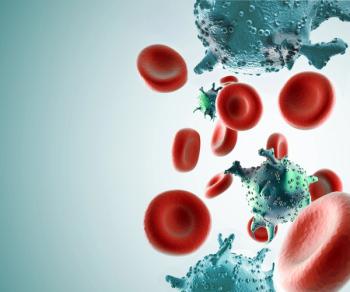
Long-Term Data Could Guide Rituximab Treatment in Follicular Lymphoma
A long-term analysis of the FOLL05 trial found favorable outcomes at 8 years in advanced-stage follicular lymphoma patients treated with three different rituximab/chemotherapy combinations.
Initial treatment with R-CHOP (rituximab plus cyclophosphamide, doxorubicin, vincristine, and prednisone) offers a better chance of durable disease control for patients with advanced follicular lymphoma (FL) than R-CVP (rituximab plus cyclophosphamide, vincristine, and prednisone) or rituximab plus fludarabine and mitoxantrone (R-FM) immunochemotherapy regimens, reported authors of a long-term follow-up analysis of the FOLL05 trial,
Overall survival (OS) appeared to be similar among patients in all three groups, although the trial was not originally powered for analysis of OS outcomes.
“With an 83% 8-year OS rate, long-term follow-up of the FOLL05 trial confirms the favorable outcome of patients with advanced-stage FL treated with immunochemotherapy,” wrote authors led by Stefano Luminari, MD, of the Istituto di Ricovero e Cura a Carattere Scientifico in Italy. “The three study arms had similar OS but different activity and toxicity profiles.”
FL represents up to 20% of newly diagnosed non-Hodgkin lymphomas. Patients initially treated with R-CVP faced a higher risk of progression than patients receiving R-CHOP. Overall, 48% of patients had not experienced FL progression at 8 years after their diagnoses.
For some patients, long-term outcomes “may translate into a possible cure for lymphoma,” the authors noted.
The availability of rituximab, a CD20-targeting monoclonal antibody, has allowed sequential immunochemotherapy regimens that are associated with improved patient outcomes.
“Although the use of anti-CD20 monoclonal antibody is confirmed by strong evidence, choice of chemotherapy backbone has been a matter of debate for many years and is still made based on limited evidence,” they noted.
The prospective, randomized, open-label, multicenter, phase III FOLL05 trial compared frontline R-CVP (intention-to-treat n = 168) with R-CHOP (ITT n = 165) and R-FM (ITT n = 171) regimens without rituximab maintenance for patients with advanced FL. For the new follow-up analysis, they analyzed data for 504 evaluable trial participants at a median follow-up of 84 months (range, 1–119 months).
Seventy-five deaths were recorded: 21 and 23 patients died in the R-CVP and R-CHOP groups, respectively, and 31 patients in the R-FM group died. The reported 8-year OS rates among ITT patients in the R-CVP, R-CHOP, and R-FM groups were 85%, 83%, and 79%, respectively; these differences were not statistically significant-the study was not designed or powered for OS analysis, the authors cautioned.
The 8-year progression-free survival hazard ratio (HR) for R-CHOP vs R-CVP, adjusted by FL International Prognostic Index 2 score, was 0.73 (P = .037). The progression-free survival HR for R-FM vs R-CVP was 0.67 (P = .009).
While the findings confirm that FL natural history has improved in the CD20-targeted immunochemotherapy era. The analysis suggests the three chemotherapy backbones might be associated with similar OS, but patients in the R-CVP group were more likely than those receiving R-CHOP to suffer lymphoma progression and to require salvage therapy. Compared to those in the R-CVP group, patients in the R-FM group had a higher overall risk of dying from causes other than lymphoma progression.
R-CHOP immunochemotherapy appears to be preferable to the other regimens for initial therapy aimed “to maximize treatment activity and increase the chance of durable disease control,” they concluded. “Conversely, R-CVP might be seen as a good option in patients for whom the goal of therapy is treatment tolerability; in this case, however, patients should be informed about the higher probability of requiring second-line treatment.
Newsletter
Stay up to date on recent advances in the multidisciplinary approach to cancer.


















































































